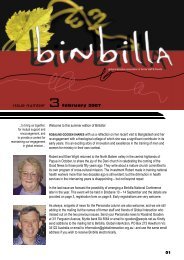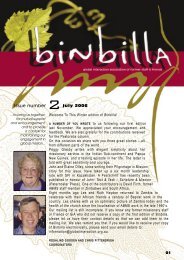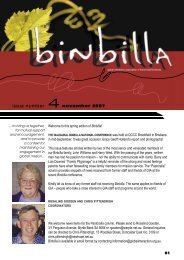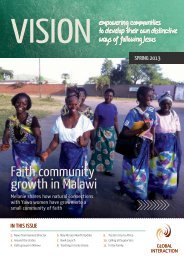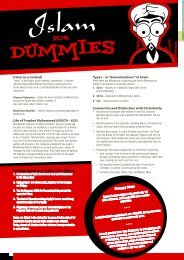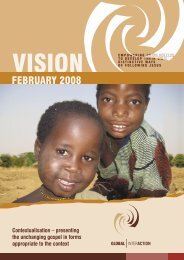Section 2: BIBLICAL MATERIALThe Old TestamentBeing the image <strong>of</strong> GodThe first description <strong>of</strong> humanity in the Bible is that we are created “in the image <strong>of</strong> God”. When written this wasradical: in surrounding cultures only kings were ever so described but here all people have that status andresponsibility. As his “image” men and women are God’s representatives in his ruling care <strong>of</strong> the world (Genesis1:26-28). The task is given in the Garden <strong>of</strong> Eden (Gen 2:15) and is renewed after the expulsion from the Garden(3:23). 1The (mis-)use <strong>of</strong> the command to “subdue and rule” illustrates how biblical statements that support one’s owninclinations can be isolated, read out <strong>of</strong> context and without the checks and balances <strong>of</strong> other statements. In theworld <strong>of</strong> ancient Mesopotamia (the region <strong>of</strong> modern Iraq) and certainly in the Bible the ideal was that a king’s rulewas to be for the benefit <strong>of</strong> the ruled! Solomon was a wise king when all the people enjoyed peace and shared theprosperity, unlike the end <strong>of</strong> his reign which focused on self-aggrandizement. 2 The image <strong>of</strong> “subdue” is certainlystrong, suggesting positive actions, not to exploit but to bring peace and harmony.The parallel command to “till the ground” significantly uses a word elsewhere translated as “serve” while the linkedphrase, “to keep it” speaks <strong>of</strong> guarding and watching over (as a shepherd “keeps” sheep, or as God“guards/protects” people; Gen 2:15). Responsible care and use <strong>of</strong> the natural environment is a God-givencommand!Care <strong>of</strong> the environmentIn a variety <strong>of</strong> ways later texts speak <strong>of</strong> care <strong>of</strong> the environment: ranging from rescuing animals (Gen 6-9), 3 toproviding for sustainable crops (giving the land opportunity to be renewed in the Sabbath year [Exodus 23:10]), tocaring for trees (Deut 20:19; contrast Hab 2:17). The purpose <strong>of</strong> the Sabbath command is to give freedom fromtasks in order to enjoy what God has given. That freedom and joy is to be shared with domestic animals, servants,and immigrant labourers (Exod 20:8-11; 23:12). The regular giving <strong>of</strong> “firstfruits” and the “firstborn” is an ongoingreminder that all belongs to God (Exod 22:29-30; 23:16).Tithes and <strong>of</strong>ferings – reflection <strong>of</strong> valuesThe use <strong>of</strong> resources is a reflection <strong>of</strong> values. The “tithe/tenth” 4 was commanded to support the religiousleadership and activities, cementing their importance in the community (and so the critique <strong>of</strong> Mal 1:6-14; 3:8-9 isthat the people treated their political leaders with more respect than God). There is support <strong>of</strong> the tribe <strong>of</strong> Leviresponsible for the worship at the tabernacle and teaching <strong>of</strong> the people (Numbers 18: 8-31; one twelfth <strong>of</strong> thepopulation), and also some provision for the poor and landless (Exod 23:11; Deut 14:22-29).The actual tithe (and their number) is complex but at least part was used for celebration by the whole community(Deut 12:17-19; 14:28-29; similarly, the Festivals, 16:11, 14-15). Added were special <strong>of</strong>ferings to atone for sin andto express gratitude to God (Leviticus 1-7). This giving may be either <strong>of</strong> animals and crops, or <strong>of</strong> cash.1E.H. Merrill, “Image <strong>of</strong> God”, Dictionary <strong>of</strong> the Old Testament:Pentateuch, eds. T.D. Alexander and D.W. Baker (DownersGrove and Leicester: InterVarsity Press, 2003), pp. 441-45.2 The contrast is between 1 Kings 3:28; 4:20 and the complaint <strong>of</strong> the people in 12:4.3 The first covenant God makes is not simply with Noah and his family but also with “every living creature that is with you” (sixtimes in Gen 9:10-17).4 The background and practice <strong>of</strong> the tithe (and the relationship <strong>of</strong> two or three tithes) is complex. Refer to any Bible Dictionary,e.g., E.E. Carpenter, “Tithe”, International Standard Bible Encyclopedia, Revised (Grand Rapids: Eerdmans, 1988), vol. 4, pp.861-64.
The giving <strong>of</strong> “tithes” is linked with the blessing <strong>of</strong> the land. Clearly a tithe is based on what has been produced.Similarly freewill <strong>of</strong>ferings at Israelite festivals were to be “in proportion to the blessing the Lord your God has givenyou” (Deut 16:10, 13-15, 17). Giving is thus related to how God has blessed and not in order to obtain blessing. 5At the same time, blessing is linked with obedience (Malachi 3:8-12), not in a mechanical way, but as anexpression <strong>of</strong> the totality <strong>of</strong> obeying God. The intertwining <strong>of</strong> human and divine giving is well expressed inDeuteronomy 26: repeated use <strong>of</strong> the verb natan “give” 6 highlights reciprocity between God’s gracious giving andthe giving required <strong>of</strong> Israel:The tithe-law <strong>of</strong> Deut … effectively pictures the obedient people <strong>of</strong> God enjoying the plenty which he haspromised them in return for their obedience… The enjoyment <strong>of</strong> benefits <strong>of</strong> the land depends uponreadiness to relinquish them… Blessing is contained in the very act <strong>of</strong> obedience. 7The community shares together in God’s presenceThroughout there is awareness <strong>of</strong> relating with God and so with others. As the “image” points to relationship, seenin the fellowship in the Garden, so in the Sabbath rest God commands us to participate with him in his “rest” fromtasks, enjoying what we have. The bringing <strong>of</strong> the tithe includes a joyful feast “in the presence <strong>of</strong> the Lord yourGod”. Further this enjoyment (<strong>of</strong> Sabbath and <strong>of</strong> tithe) is always communal, shared by all irrespective <strong>of</strong> social oreconomic situation (Exod 20:8-11; Deut 17:22-29).The responsibility to care for all in the community is throughout the Old Testament: “The right to property was inprinciple subordinated to the obligation to care for the weaker members <strong>of</strong> society” (Amos 5:10-12, 8:4-8, Isa.5:8-10, 10:1-3). 8 The incident <strong>of</strong> Naboth’s vineyard illustrates the way in which property was held in trust for futuregenerations (1 Kings 21:1-3), putting into practice the belief that the Lord was the owner <strong>of</strong> the land and that hehad assigned it to the families (Leviticus 25). By the time <strong>of</strong> Jesus however the impact <strong>of</strong> Greco-Romancolonization led to extensive exploitation (reflected in the treatment <strong>of</strong> labourers, e.g., James 5:1-6).Restoring livelihoodsVarious laws recognise the vicissitudes <strong>of</strong> economic and climatic conditions, but seek to give long-term protection<strong>of</strong> the economic viability <strong>of</strong> all extended families throughout the generations. 9 These range from the immediacy <strong>of</strong>the limitation <strong>of</strong> pr<strong>of</strong>its, allowing the poor to collect from crops (Lev 19:9-10 – part <strong>of</strong> “being holy”), not charginginterest (Lev 25:35-38 10 ) and amelioration <strong>of</strong> debt-slavery (Lev 25:39), to long-term laws relating to land and debtbondage.Particularly striking are laws <strong>of</strong> the “sabbatical year” and “jubilee”, 11 the fiftieth year when one is “toproclaim liberty throughout the land”, forgive debts, release people from debt-bondage (working for others) andreturn land (Leviticus 25).How these were implemented is unclear: the jubilee is mentioned as a reality in Num 36:4, and as a future ideal inEzek 46:17. The sabbatical year is implemented in Neh 10:31 (compare Jer 34:8-22). Non-implementation wasdue no doubt to the initiative belonging those in power. Sadly the biblical narrative reflects wider society through thecenturies in ways those who have cling to what they have and even devise ways to gain (and justify having) more!5This explains the unexpected commandment in the context <strong>of</strong> festival celebration for judges not to take bribes (Deut 16:18-20). Human leaders are to be like God who does not act on the basis <strong>of</strong> bribes (gifts to gain attention or favour).6 Vs 1, 2, 3, 6, 9, 10, 11, 12, 13, 14, 15, 19.7 J.G.McConville, Law and Theology in Deuteronomy (JSOT Press, 1984), pp. 82-84.8 M. Hengel, Property and Riches in the Early Church (London: SCM, 1974), p. 13.9 C.J.H. Wright, Living as the People <strong>of</strong> God: the relevance <strong>of</strong> Old Testament ethics (Leicester: Inter-Varsity, 1983), espec. pp.183-87 [extensively revised and updated in Old Testament Ethics for the People <strong>of</strong> God (Downers Grove, IL: InterVarsity,2004), pp.154-80]. See also his God’s People in God’s Land (Grand Rapids: Eerdmans, 1990).10 The NIV’s “excessive interest” appears to be a modernization! The TNIV (2005) rightly has just “interest”. The point is thatone is not to take advantage <strong>of</strong> the economic difficulties <strong>of</strong> a brother or sister (as distinct from loans in an industrialized societythat are made for investment purposes).11 The English “Jubilee” is a from the Hebrew yobal , the ram’s horn, the blowing <strong>of</strong> which inaugurated the fiftieth year. Fordiscussion <strong>of</strong> the sabbatical year and jubilee and relevance for today see the works <strong>of</strong> C.J.H. Wright (note 9), also P.A. Barker,“Sabbath, Sabbatical Year, Jubilee”, Dictionary <strong>of</strong> the Old Testament: Pentateuch, pp. 695-706.



